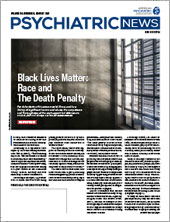Many people have experienced distress since the COVID-19 pandemic began, and they often use the diagnosis of posttraumatic stress disorder (PTSD) to describe their experience. But exhibiting symptoms of PTSD does not mean the individual meets the clinical criteria for the disorder, explained Carol North, M.D, M.P.E.
North presented at APA’s 2021 online Annual Meeting in the session “Disaster Mental Health Epidemiology and Nosology: Perspectives From Three Decades of Research.” She is the medical director of the Altshuler Center for Education and Research at Metrocare Services in Dallas and a professor psychiatry at the University of Texas Southwestern Medical Center, where she is also director of the Division of Trauma and Disaster.
Disaster mental health is a relatively young field, she explained, and the diagnostic criteria for PTSD have changed significantly over the years. “It’s an evolving area of knowledge that is increasingly providing more and more data to help us decide how to respond to disasters and how to respond best,” she said.
PTSD was not recognized as a diagnosis until 1980, she pointed out, when it was included in DSM-III. “PTSD is an unusual diagnosis because this disorder is conditional,” she said. “The diagnosis is based on having trauma exposure. If there is no exposure, it’s not PTSD.”
There are three major elements of a PTSD diagnosis, North explained: The traumatic stressor, the exposure, and the symptom response. The traumatic stressor is defined as a threat to life or limb, so an experience such as a divorce is not considered a traumatic event. Further, there are four types of exposure: direct exposure to the traumatic event, witnessing the event, having a loved one who experiences it, or being exposed to repeated or averse details of the trauma (though not through the news media).
While the traumatic stressor and exposure are objective, the symptom response, defined as symptoms beginning or worsening after the traumatic event, is a subjective element that varies between individuals. Symptoms may include intrusive memories, avoidance of thoughts and feelings, numbing, trouble concentrating, and being easily startled, among others. North’s research has illustrated that avoidance and numbing are core to the psychopathology of PTSD.
“We don’t want to conflate these three elements of PTSD,” North said. If a person exhibits symptoms, that doesn’t necessarily mean they were caused by a traumatic event or that the person was exposed to a traumatic event. Patients with symptoms should be treated even if they do not meet the criteria for PTSD, she said, but inappropriately diagnosing PTSD trivializes the diagnosis.
Most emotional responses to disaster trauma are not pathological, North emphasized. “People are resilient,” she said. “Most people don’t become psychiatrically ill after a disaster.” Distress, however, is normal after a disaster, and it is important to differentiate distress from pathology. After disasters, people may experience a range of issues, such as stress, grief, mood and anxiety disorders, or depression.
In most of her studies, North said, the prevalence of major depressive disorder is usually second to PTSD after a disaster. The September 11 terrorist attacks, however, were unique in that depression was more prevalent than PTSD in North’s data set.
The September 11 attacks were so complex that they required the field to rethink where to draw the line in terms of who is considered to have been exposed to a disaster. Now, the COVID-19 pandemic is causing other problems for the field, she said, because of how the criteria for PTSD are described in DSM-5.
Studies that have investigated the prevalence of PTSD or PTSD symptoms since the start of the pandemic have estimated rates of PTSD that range widely. For example, four studies on the prevalence of PTSD symptoms in hospitalized COVID-19 patients found rates ranging from 12% to 96%, North said.
Naturally occurring illnesses do not meet the criteria for trauma outlined in the PTSD criteria, however, and the fear of exposure does not meet the definition of trauma. “If the stress is not trauma related, what do we do with these outcomes of COVID-19?” North said. There are numerous options, including rewriting the PTSD criteria so that they include the pandemic virus; creating a new stress-related syndrome devoted to acute, life-threatening illnesses; or invoking traditional psychiatric syndromes, such as previously defined disorders, that begin after exposure to COVID-19.
“But in order to make these decisions, we need good data,” she said. “We need to compare people who are exposed to the virus in the pandemic to those who are exposed to traditional, qualifying traumatic events and look at the symptoms and syndromes to see if these things look similar or distinct.”
Yet, she added, “even though, particularly in the current pandemic, there’s a lot that we don’t know, there is also a lot that we do know from existing mental health research that has given us general principles of guidance and can help us develop good response efforts for the people who have been in disasters.” ■
